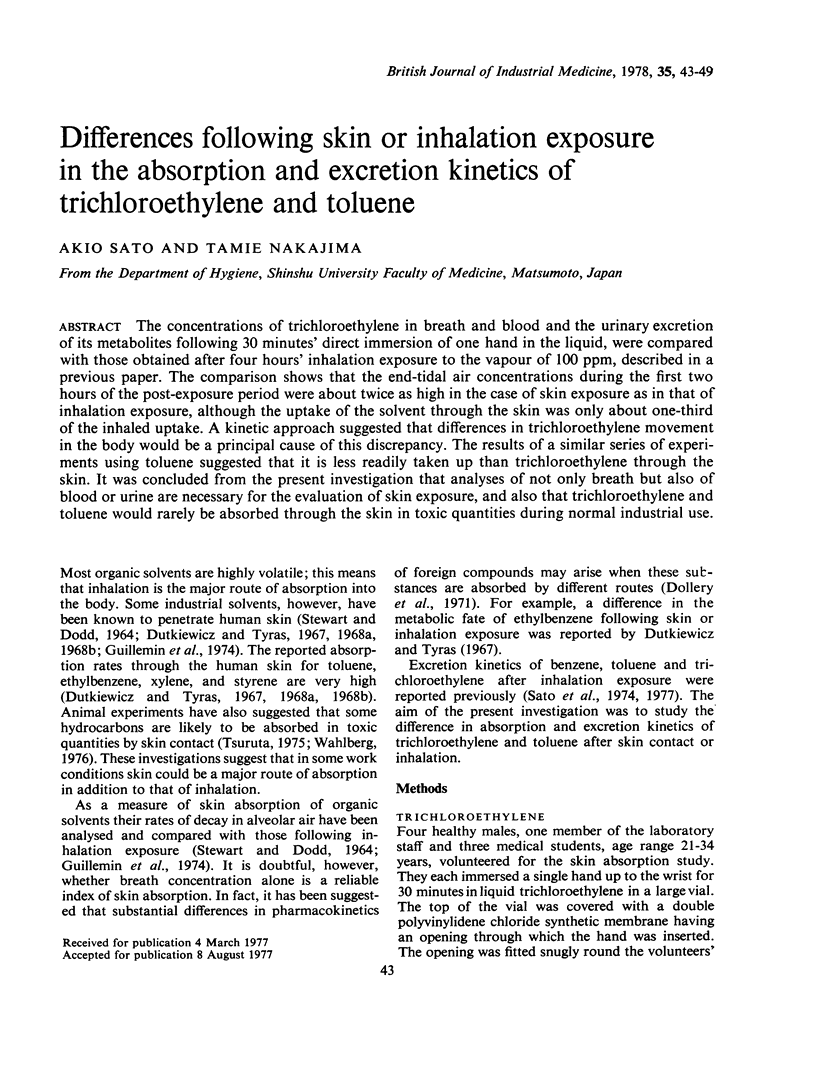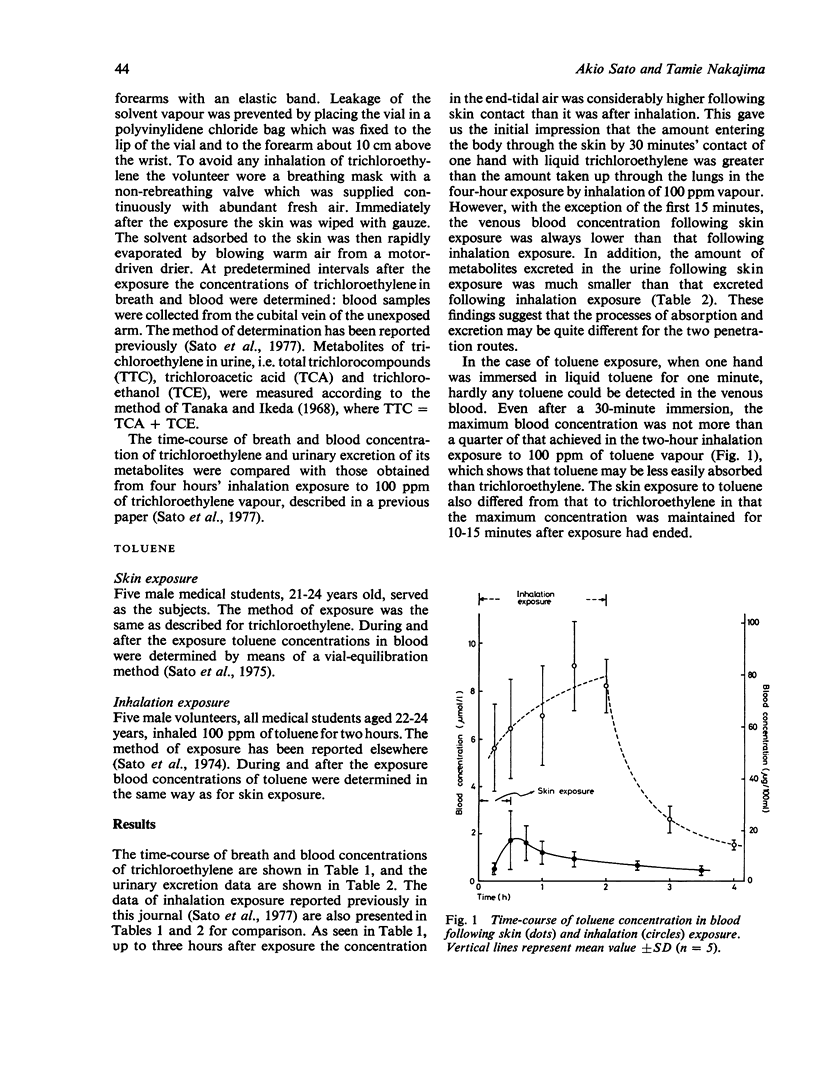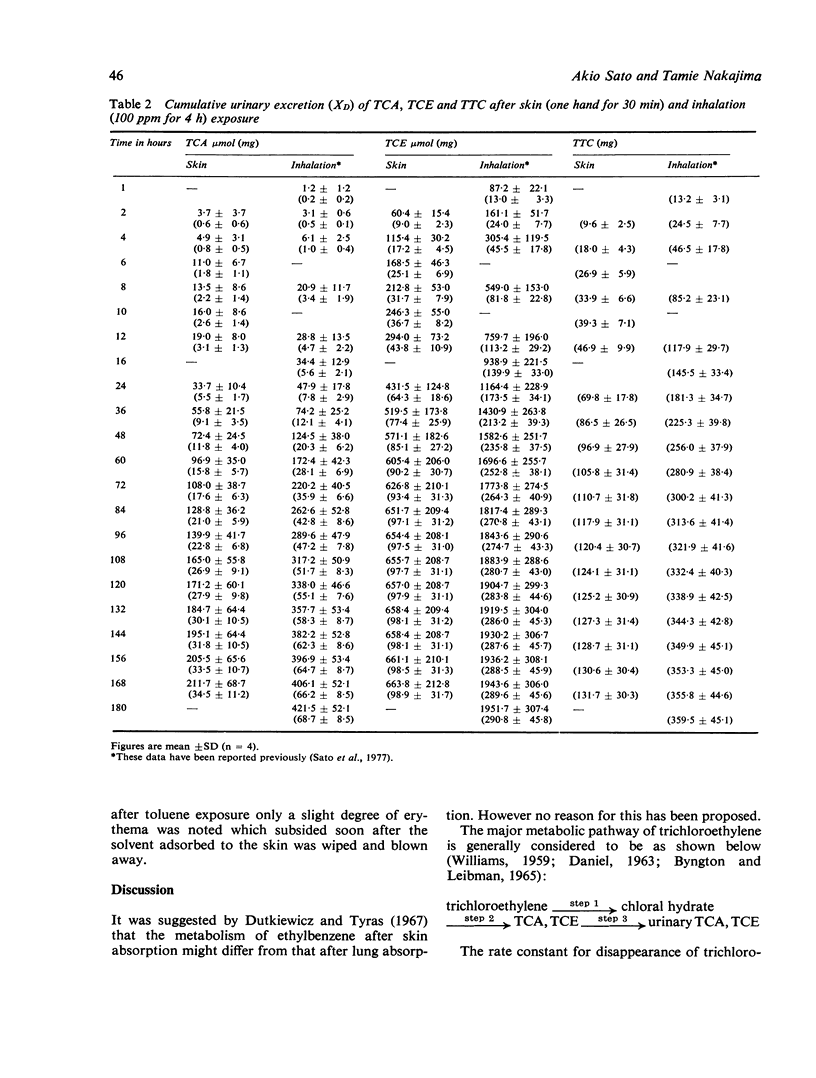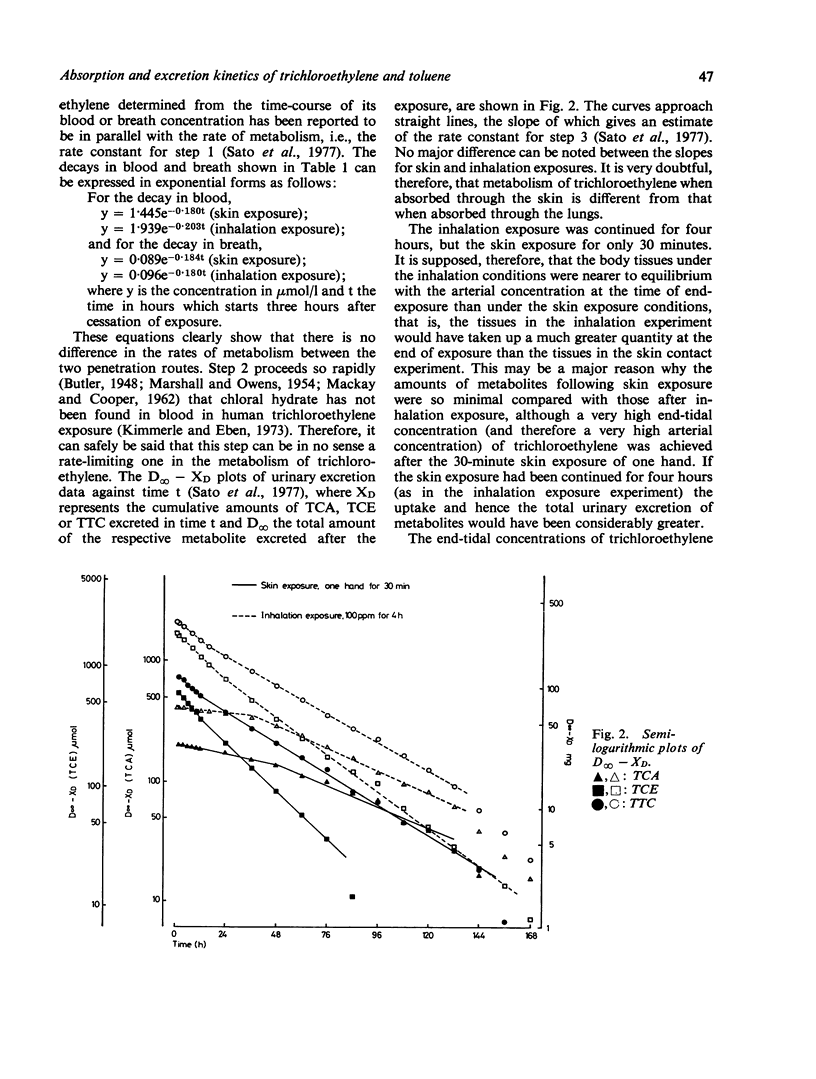Abstract
The concentrations of trichloroethylene in breath and blood and the urinary excretion of its metabolites following 30 minutes' direct immersion of one hand in the liquid, were compared with those obtained after four hours' inhalation exposure to the vapour of 100 ppm, described in a previous paper. The comparison shows that the end-tidal air concentrations during the first two hours of the post-exposure period were about twice as high in the case of skin exposure as in that of inhalation exposure, although the uptake of the solvent through the skin was only about one-third of the inhaled uptake. A kinetic approach suggested that differences in trichloroethylene movement in the body would be a principal cause of this discrepancy. The results of a similar series of experiments using toluene suggested that it is less readily taken up than trichloroethylene through the skin. It was concluded from the present investigation that analyses of not only breath but also of blood or urine are necessary and toluene would rarely be absorbed through the skin in toxic quantities during normal industrial use.
Full text
PDF






Selected References
These references are in PubMed. This may not be the complete list of references from this article.
- Byington K. H., Leibman K. C. Metabolism of trichloroethylene in liver microsomes. II. Identification of the reaction product as chloral hydrate. Mol Pharmacol. 1965 Nov;1(3):247–254. [PubMed] [Google Scholar]
- DANIEL J. W. THE METABOLISM OF 36C1-LABELLED TRICHLOROETHYLENE AND TETRACHLOROETHYLENE IN THE RAT. Biochem Pharmacol. 1963 Aug;12:795–802. doi: 10.1016/0006-2952(63)90109-6. [DOI] [PubMed] [Google Scholar]
- Dollery C. T., Davies D. S., Conolly M. E. Differences in the metabolism of drugs depending upon their routes of administration. Ann N Y Acad Sci. 1971 Jul 6;179:108–114. doi: 10.1111/j.1749-6632.1971.tb46893.x. [DOI] [PubMed] [Google Scholar]
- Dutkiewicz T., Tyras H. A study of the skin absorption of ethylbenzene in man. Br J Ind Med. 1967 Oct;24(4):330–332. doi: 10.1136/oem.24.4.330. [DOI] [PMC free article] [PubMed] [Google Scholar]
- Dutkiewicz T., Tyras H. Skin absorption of toluene, styrene, and xylene by man. Br J Ind Med. 1968 Jul;25(3):243–243. doi: 10.1136/oem.25.3.243. [DOI] [PMC free article] [PubMed] [Google Scholar]
- Dutkiewicz T., Tyras H. The quantitative estimation of toluene skin absorption in man. Int Arch Arbeitsmed. 1968;24(3):253–257. doi: 10.1007/BF00345921. [DOI] [PubMed] [Google Scholar]
- Guillemin M., Murset J. C., Lob M., Riquez J. Simple method to determine the efficiency of a cream used for skin protection against solvents. Br J Ind Med. 1974 Oct;31(4):310–316. doi: 10.1136/oem.31.4.310. [DOI] [PMC free article] [PubMed] [Google Scholar]
- Kimmerle G., Eben A. Metabolism, excretion and toxicology of trichloroethylene after inhalation. 2. Experimental human exposure. Arch Toxikol. 1973;30(2):127–138. doi: 10.1007/BF02425930. [DOI] [PubMed] [Google Scholar]
- MACKAY F. J., COOPER J. R. A study on the hypnotic activity of chloral hydrate. J Pharmacol Exp Ther. 1962 Mar;135:271–274. [PubMed] [Google Scholar]
- MARSHALL E. K., Jr, OWENS A. H., Jr Absorption, excretion and metabolic fate of chloral hydrate and trichloroethanol. Bull Johns Hopkins Hosp. 1954 Jul;95(1):1–18. [PubMed] [Google Scholar]
- STEWART R. D., DODD H. C. ABSORPTION OF CARBON TETRACHLORIDE, TRICHLOROETHYLENE, TETRACHLOROETHYLENE, METHYLENE CHLORIDE, AND 1,1,1-TRICHLOROETHANE THROUGH THE HUMAN SKIN. Am Ind Hyg Assoc J. 1964 Sep-Oct;25:439–446. doi: 10.1080/00028896409342621. [DOI] [PubMed] [Google Scholar]
- Sato A., Nakajima T., Fujiwara Y. Determination of benzene and toluene in blood by means of a syringe-equilibration method using a small amount of blood. Br J Ind Med. 1975 Aug;32(3):210–214. doi: 10.1136/oem.32.3.210. [DOI] [PMC free article] [PubMed] [Google Scholar]
- Sato A., Nakajima T., Fujiwara Y., Hirosawa K. Pharmacokinetics of benzene and toluene. Int Arch Arbeitsmed. 1974;33(3):169–182. doi: 10.1007/BF00538916. [DOI] [PubMed] [Google Scholar]
- Sato A., Nakajima T., Fujiwara Y., Murayama N. A pharmacokinetic model to study the excretion of trichloroethylene and its metabolites after an inhalation exposure. Br J Ind Med. 1977 Feb;34(1):56–63. doi: 10.1136/oem.34.1.56. [DOI] [PMC free article] [PubMed] [Google Scholar]
- Tanaka S., Ikeda M. A method for determination of trichloroethanol and trichloroacetic acid in urine. Br J Ind Med. 1968 Jul;25(3):214–219. doi: 10.1136/oem.25.3.214. [DOI] [PMC free article] [PubMed] [Google Scholar]
- Wahlberg J. E. Percutaneous toxicity of solvents. A comparative investigation in the guinea pig with benzene, toluene and 1,1,2-trichloroethane. Ann Occup Hyg. 1976 Nov;19(2):115–119. doi: 10.1093/annhyg/19.2.115. [DOI] [PubMed] [Google Scholar]


